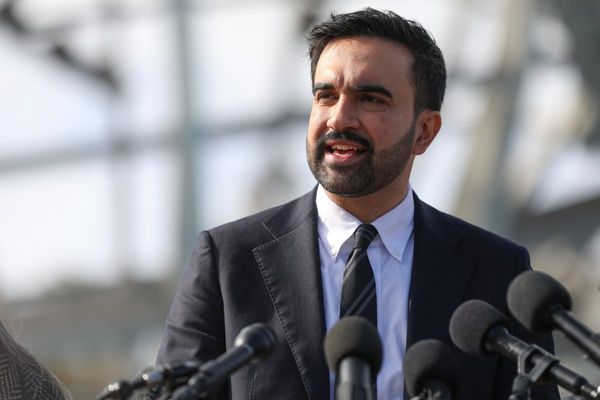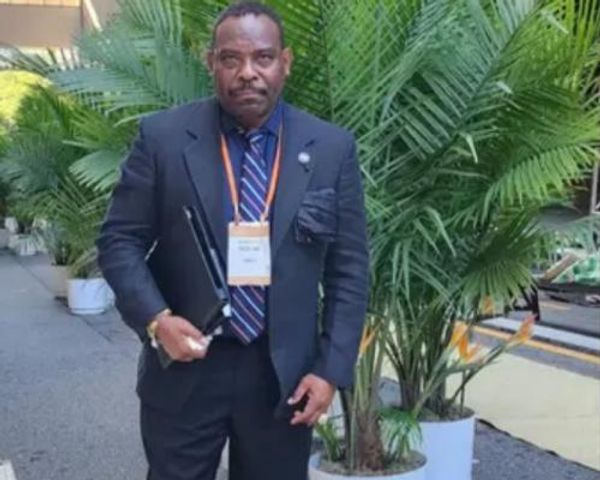

Leaving home at a young age isn’t just tough, for many young Aussies, it’s a matter of survival. Whether it’s couch surfing, relying on temporary shelters, or sleeping rough, it’s a national issue that’s far more widespread — and pressing — than many may realise.
Nearly 40 per cent of Australia’s homeless population is under the age of 24, with a staggering 43,000 young people nationally experiencing homelessness, according to the latest research from NSW’s peak body for youth homelessness services, Yfoundations.
But, a lack of capacity and resources has meant around half of the people seeking a place to sleep are being turned away.
Speaking to PEDESTRIAN.TV, John Macmillan, chief executive of Yfoundations, has urged immediate attention to address this national crisis affecting Gen Z.
The public’s idea of what homelessness often looks like misses the reality for most young people, he said.
“While the most common perception of homelessness is people sleeping rough on the streets of towns and cities — and it’s true that some young people do have to sleep rough — one of the most predominant forms of youth homelessness is couch surfing.
“That’s where children and young people who don’t have a stable home to live in end up staying wherever they can, whether it’s the houses of friends and relatives or with strangers they meet along the way,” he said.

The constant struggles for shelter can significantly impact their wellbeing, he added, with these young people often spending time in overcrowded, often unsafe, environments that may not be supportive of social connections or enabling them to stay in school.
And by the time young people actually do reach out for specialist help, it’s often a last resort.
“This instability can have a significant impact on their health and wellbeing, to the extent that around half of the young people who do access specialist services report having mental health concerns,” he added.
Another big problem? Youth homelessness is often treated the same as adult homelessness, even though the needs are completely different.
“There’s a significant risk of the ‘adultification’ of children and young people, where they’re expected to fit into an adult environment that doesn’t recognise or cater for their developmental needs,” Macmillan pointed out.
“The growing crisis of child and youth homelessness in Australia highlights the need for a specific and specialised focus. Without that focus, the needs of children and young people will continue to be under-recognised and addressed.”
Safe to say, the figures paint a grim picture for Australia’s young people seeking out help and support. That’s why Yfoundations is calling on the federal government to step up by formulating a comprehensive national youth homelessness strategy to adequately address this crisis.
“Most nights I would be walking around and avoiding sleep because I was so scared”
For Jennifer, 18, her early life in Sydney saw a number of significant challenges. Growing up with a single parent experiencing mental health struggles, she recalls a period marked by tons of conflict and displacement. By the time she was 13, violence escalated to the stage she felt unsafe, and she left home.
“I was only 13, so I was just a little girl,” she told PEDESTRIAN.TV.
“[These years] were definitely very different to my classmates. I left school for a bit, and went back in Year 9 or Year 10. I wasn’t living that normal life. It was very different from everyone else around me.”
Amid all the uncertainty, the toll on her wellbeing was severe, impacting both her physical and mental health.
“Both of these were so affected during this time,” she recalled. “I was anorexic, I wasn’t weighing a lot, I wasn’t eating a lot.”
Her mental health also spiralled, leading to “many, many” hospital visits, where the sense of isolation was particularly difficult.
“The hardest times were probably feeling very alone. I didn’t have my mum show up for me at all, or my dad, he’s not even in the country. I didn’t really have many people show up for me when I was in hospital, getting sectioned or needing the help,” Jennifer said.

She eventually managed to move into a crisis refuge — which is where she had her 16th birthday — and with the right support and care, everything started to change.
Looking back, Jennifer recalls actively engaging with her Department of Communities and Justice (DCJ) case-worker proved to be a stabiling presence in her life. She also described a “really awesome sense of community” from her classmates, teachers, and psychologist, all of whom contributed to a sense of belonging.
This unwavering support was pretty crucial, Jennifer said, when there’s so much misunderstanding and stigma around youth homeless.
“People are just so mean. People can be heartless, and they say the most horrible things. But every young person deserves a little bit of grace. Most people don’t even bother to put in that care, and it leads to really bad cycles,” she said.
“For the longest time, I felt super insecure and lacked confidence. But now, since getting my HSC, I feel like I’m hitting goals, and there’s so many employment services that help me as well.
“I just got my real estate license certificate, and I’m actually going into commercial cookery next month. I just want to do it all, and I want to accomplish lots of things.”
Speaking to P.TV., Canberra resident Marija, 24, remembers a privileged childhood in a big family, as one of five children. But her life changed after she had to make the split decision to leave home at 15, spurred by violence and a breakdown with the family.
For around three months during the school holidays, she was sleeping rough, finding temporary refuge on friends’ couches when possible. She spent most nights walking around, trying to stay awake.
“Most nights, I would be walking around and avoiding trying to sleep, because you’re so scared that someone’s going to come from behind you. Whether you’re gonna be raped or stabbed or whatever it might be, you have no idea about the dangers that are out there, and I was just 15,” Marija told P.TV.
“There’s all those negative associations about youth homelessness, or even homelessness in general, because you see people sleeping in the day. But I think what people don’t understand is what they’re doing at night. They’re just trying to survive.”

The physical toll during this period was immense, Marija explained, fighting the cold and hunger, while trying to navigate mental health challenges.
“You’re trying to keep sane, because your mental health is deteriorating by the day. You’ve got no certainty, so everything’s just unstable. And if you don’t even have a roof of your head, how are you meant to focus about anything else in your life, let alone getting a job, or going to school, or studying or doing homework?”
She describes being suddenly thrust into a harsh reality she never imagined, encountering individuals struggling with alcohol or drug challenges, and feeling utterly vulnerable and out of place at her young age. Relief, thankfully, arrived when school resumed in the new year, and she sought out a teacher.
“I just remember going up to her and balling my eyes out. My hair was dishevelled, I was in my pyjamas, I didn’t even have a school uniform with me. I was an absolute mess,” she recounted.
The teacher proved to be her first lifeline, connecting her with essential youth support services. Marija eventually moved into emergency accommodation at a refuge, followed by 18 months in transitional housing, and then transferred into social housing for the next three years. Through this time, she was able to continue her education, completing Year 12 and going on to earn multiple VET qualifications, including a Certificate IV in Mental Health.
At the age of 22, she was able to purchase her own home.
“People talk about the Australian dream of wanting to own their own property, and it’s not an easy thing to achieve. For me to finally have stability when I’ve spent 10 years of my life without stability, it’s a euphoria feeling, I can’t even describe what it feels like,” she said.
“It’s incredible, and I’m proud of everything that I’ve had to work so hard for to be able to achieve that, but at the same time, it’s really been a community effort. Without all the support in place, whether it was my friends, the school, the support worker, extended family, even my football club… All these people working together to keep me connected and away from bad choices. There’s so many challenges that [could have] changed the whole trajectory.”

According to Marija, people “always throw around a word like support”, but she believes there’s much more to it than many realise.
“It’s hard to build the rapport, to actually be vulnerable and open up, particularly for young people when you’ve just lost trust in your parents who are meant to love you, unconditionally and care for you. To then trust another adult in your life is extremely difficult,” she said.
“For me, it was the fact that I was actually connected with another adult that didn’t let me down. So I’m really lucky I got to meet the same youth worker for every Wednesday, at the same time at the same place, for several years. In the community sector, there’s such a high turnover of staff, so it’s hard to have that consistency and the same worker, but that’s what made the difference for me.”
Looking back at her experience, she’s passionate about debunking misconceptions around the issue of youth homelessness.
“It’s not something I had planned, something I had wanted… Sometimes people are put into a position where they have no other option. If there’s violence in the home, some people have to make the difficult choice [to leave] and it doesn’t even feel like a choice, that you would have to sleep on the street rather than live there.”
The issue can also be quite hidden for young people, Marija pointed out. One of the most predominant forms of youth homelessness is couch surfing, while trying to navigate the everyday challenges of growing up, like school and social pressures.
“There’s so much change in a young person’s life and at the end of the day, we are just trying our very best to get through it. It’s tough living in this environment, and then we have to deal with the judgement and the pressures of what people think. But there’s so much more underneath it,” she said.
Jennifer echoed the sentiment, sharing a message of hope for anyone else who may be going through a tough time.
“Definitely give yourself some grace. Be kind to yourself, because it takes time,” she said.
She’s backed calls to tackle youth homelessness head on, pointing out it’s these people struggling today who will be the next change makers.
“It’s so important to uplift us while we’re young and while we’re vulnerable, because it shapes the person. It shapes the society that we live in,” she told P.TV.
Need for national plan to tackle youth homelessness
Despite representing nearly half of the total homeless population, experts argue young people are often overlooked, with insufficient resources and a lack of a national strategy leaving them vulnerable and unsupported.
With this, Yfoundations’s petition calls on the federal and state governments to make ending youth homelessness a national priority with the development of a national plan.
So, what are the tangible steps and measures that such a plan should include? For one, it needs to focus on prevention and early intervention, Macmillan told P.TV., and enhancing the service system to support young people who do experience homelessness.
“Child and youth homelessness often occurs due to a range of gaps in existing service systems,” he said, noting that addressing family support and child protection is crucial.

Plus, young people who do become homeless require a continuum of services, Macmillan elaborated, starting from adequate crisis accommodation to help stabilise their situation, and start to plan their next steps.
“Given that 50 per cent of the young people seeking crisis accommodation have to be turned away due to inadequate resourcing of these services, there’s an obvious measure for improvement,” he said.
Other areas include a commitment to medium-term and transitional housing that can help young people live independently and move out of homelessness, often into sustainable private sector housing arrangements.
It’s also crucial to recognise and respond to the devastating impact of family and domestic violence on young people, and its relationship to homelessness, he said. But, current financial support like Youth Allowance simply doesn’t go far enough.
“They don’t match the cost of living and need to be increased to enable young people to access the accommodation they need,” Macmillan said.
So, what can you do to help?
Marija also has a message for the everyday Aussie who’d like to help: “A lot of it comes back to the language that we’re using and the judgement that’s there. I don’t think that you have to be in a support worker role to have an influence and to change someone’s life. Even the teacher listening to me in that time I really needed it, it made all the difference.
“You don’t need a title, you don’t need a specific role to be able to give that support. It’s about listening to the young person, not having judgement, and being there so that they feel heard.”
Keen to get involved? There’s plenty of organisations where you can donate, or volunteer your time, such as Yfoundations, Youth Off The Streets, Kids Under Cover, and Stepping Stone House.
The post ‘Just Trying To Survive’: Inside Australia’s Youth Homelessness Crisis appeared first on PEDESTRIAN.TV .







